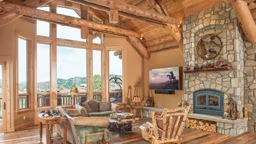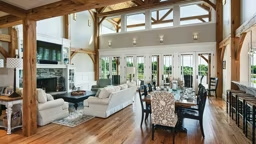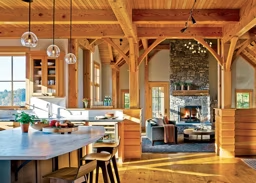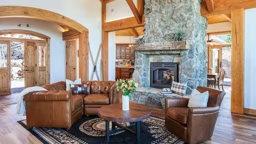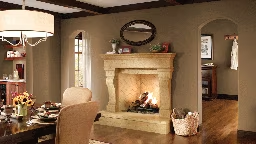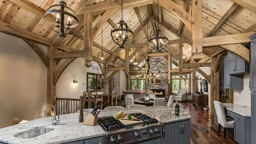
What does “cozy” mean to you? A mug of coffee on the porch during sunrise? A good book to curl up with in front of the roaring fire? Or maybe it’s just the feeling of comfort and efficiency in your own home — having a sense of order and knowing exactly where to find everything you need.
 Of course, cozy is relative. If you grew up in a castle, downsizing to a 5,000-square-foot dwelling might be cause for alarm. But for most of us, feeling comfortable is all about scale.
Of course, cozy is relative. If you grew up in a castle, downsizing to a 5,000-square-foot dwelling might be cause for alarm. But for most of us, feeling comfortable is all about scale. Big, open spaces can feel overwhelming; just as too-small niches can bring on a case of claustrophobia. Yet we all strive for it — that perfect blend of cozy and space. Not too big, not too small. Only you can decide how much house you need, but once you’ve got the square footage figured out, there are some great ways to make it feel like home.
1. Factor in a transition.
The overhead drama of post-and-beam homes can be a bit intense, especially if the soaring ceiling and huge truss system is the first thing you see when you walk in the door. To create a bit of suspense and avoid overwhelming your guests, James Driesch, director of design at Claremont, New Hampshire-based Timberpeg, suggests a small, single-level foyer.
“There’s a tendency to design overstated entries in timber homes. But they don’t necessarily have to be a big-volume space — that can be pretty intimidating. I prefer a transitional space, with lower ceilings,” says Driesch. That way, you’ll have a comfortable space to greet and send off your guests. Driesch also tries to avoid entries that open directly to a large great room, explaining, “It doesn’t leave anything to discover, it’s not very inviting and it’s not an intimate way to greet your guests.”
2. Let the sunshine in.
Sunshine is nature’s little pick-me-up, so lots of windows and glass doors are key to creating a bright and welcoming space. It’s especially important to consider this if you’re going to have a walkout basement where you’ll want to let in as much natural light as possible.
Driesch recommends trying for 9-foot ceilings in the lower level, which usually allows for oversized, 8-foot-tall windows to be installed. “A little extra height in your windows makes a tremendous difference,” he says.

3. Vary your ceiling heights.
Because of the frame, most timber homes are based around an open floor plan. This grand space is wonderful for entertaining and for showing off those gorgeous beams, but it leaves a little bit to be desired when it comes to the cozy factor. “One of the problems I see is that too much volume doesn’t make for a comfortable living space,” says Driesch. “In certain areas, some high dramatic ceilings are exciting, but you really should plan for some lower ceilings and cozier spaces.”Driesch recommends using a two-story ceiling for the great room, then bringing your kitchen ceiling down to a standard height, explaining, “High, vaulted ceilings in a kitchen makes it a little more difficult to install cabinetry, lighting and venting.” Dining areas, which are social spots by nature, also are good candidates for two-story spaces, he says.
See also 3 Tips for Downsizing Your Timber Home
 4. Create nooks and bump-outs.
4. Create nooks and bump-outs.
Designing cozy nooks that hold a breakfast table, reading chair or game area is a great way to carve out space for casual entertaining and relaxing. To accomplish this, think about incorporating architectural details into your design to further distinguish these spots from the open great room area. This could be in the form of a half-wall or a step down or a step up; just a little subtle change that shows that you’re entering a different area. The best place in your floor plan for these welcoming nooks and crannies? Design experts say to look for a “dead-end space,” like a little study at the end of the great room.
5. Keep it small, but not too small.
Sure, the term cozy often is code for “small.” But if you’re looking at a floor plan that’s too tiny, the only word to describe it is cramped. If you have the budget, devoting some square footage to auxiliary rooms can absolutely make your home more usable, more comfortable and more functional.“With a larger home, your options begin to increase,” Driesch says. “Now you can have a den or a media room. You can have office space or a library. Those are the smaller, more intimate spaces for sitting down and having one-on-one conversations or just to get away from it all.”
3 Rules to Making a Cozy Loft
More than just the basics, custom home building is all about incorporating architectural details to create a comfortable design that suits your lifestyle. And no space complements the timber-frame aesthetic while boosting your home’s cozy factor like a loft. No matter how you decide to use your loft, though, consider these three rules before you build.Rule No. 1: Build in some privacy.
Although an open-railing design maximizes both the view and the light, it may not be the best option if your loft will function as a guest room. Instead, consider choosing a half-wall design. If you still decide to go with the open railing for looks, you might think about installing shutters or a movable screen for added privacy. But creating visual privacy is only half the battle. To contain noise from a loft, where sound tends to bounce off the ground, consider insulating the floor.A layer of carpet will stifle sound, but a conversation spoken in normal tones in the loft usually can be heard easily in the rooms below. To reduce the noise even more, consider a built-up floor system with a layer of sound-deadening drywall placed over the floor decking. Have your builder then follow this with a layer of “sleepers” (2-by-4s or 4-by-6s) and a second subfloor.

Rule No. 2: Remember to account for slanting walls.
When you’re dealing with a loft space, you have to think about the roof’s pitch, which can sometimes be slanted or uneven. For example, if you’re thinking of making the space into a library or a quiet reading spot, you’ll need to plan to avoid bumped heads. Make your walls at least 6 feet high for bookshelves, as well as ease getting in and out of overstuffed armchairs or sofas.On the other hand, for a playroom or a meditation room, a steep pitch might be fine — especially with knee walls for storage. Take the area along the loft edge where there isn’t enough ceiling height to create usable floor space and close this wall off with a knee wall, with a height of 3 to 4 feet to create an enclosed space that’s ideal for storage.
See also Space Planning: 5 Rooms for a Small Floor Plan
Rule No. 3: Design your loft to take in the views.
Lofts can be situated over kitchens or adjacent to bedrooms to provide a sitting area, but most people want to overlook the great room to take advantage of the views from the huge windows. If the loft is located over the front entrance, it creates a cozy foyer before getting that ‘wow’ factor when you enter the vaulted great room. However, design experts recommend your loft not be more than a third of the size of the great room to guard against it hanging too far out over the lower space. Close Quarters
Close Quarters
In not-so-big homes, there’s a fine line between cozy and confining. Read on for designers’ top tips to tread on the right side of that divide.
Minimize your halls and transitional spaces.
One way of conserving space is to make sure your design elements are serving double duty, says James Driesch, director of design at Timberpeg based in Claremont, New Hampshire. For example, a staircase or a fireplace can reduce the need for interior walls if they function as space dividers, as well.Focal points matter in smaller spaces.
“Use a focal point like a fireplace or a window wall at the far end of the room to draw people’s eyes,” suggests Driesch. “It makes the house feel larger.”Maximize the open floor plan.
Good news: Airy layouts already feel bigger than they are. Driesch points out that having a combination great room, kitchen and dining room is a good idea because those rooms can borrow a bit of space from one another when necessary. The best way to do this? Use the dining room as a transitional area, where it connects with the kitchen and the great room.
Keep the color muted.
In smaller homes, designers recommend keeping it simple on wall colors. Nothing stark, but more monochromatic to allow the space to feel larger.See also How to Maximize Space in Your Timber Home Plan




